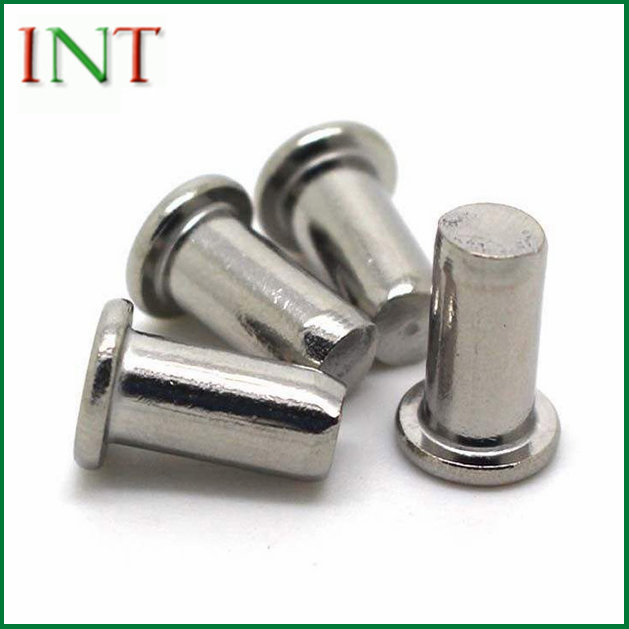Solid Steel Rivets: The Backbone of Strong, Durable Connections
2025-02-20
When it comes to creating strong, permanent connections between materials, solid steel rivets stand as one of the most reliable solutions. Used across various industries — from aerospace and automotive to construction and manufacturing — these small but mighty fasteners play a crucial role in holding materials together with immense strength and durability.
In this blog, we’ll explore what solid steel rivets are, their unique benefits, common applications, and why they remain a top choice for heavy-duty fastening.
What are Solid Steel Rivets?
A solid steel rivet is a type of fastener made from solid steel, designed to join two or more materials together. Unlike hollow rivets or blind rivets, which have a hollow center and are often used in specific applications, solid steel rivets are made entirely from steel, making them ideal for situations that demand maximum strength and reliability.
The rivet consists of two main parts: the rivet body and the rivet mandrel. The body is the main shaft, typically cylindrical, while the mandrel is the protruding portion that holds the rivet in place until it is set. When a solid steel rivet is installed, the protruding mandrel is deformed or "hammered" over the edge of the rivet body, creating a permanent, secure bond.
Key Features of Solid Steel Rivets
1. High Strength and Durability
Solid steel rivets are known for their exceptional strength and durability. Steel, being one of the strongest materials used in construction and manufacturing, ensures that the rivet can withstand heavy stresses, harsh environments, and extreme conditions. This makes solid steel rivets ideal for structural applications where safety and long-term performance are critical.
2. Resistance to Vibration and Impact
One of the major advantages of using solid steel rivets is their ability to resist vibration and impact. This is particularly important in industries such as aerospace and automotive, where components are subjected to constant motion, jolts, and vibrations. The rivet’s strong and secure connection ensures that materials stay firmly in place, even under challenging conditions.
3. Corrosion Resistance
Steel rivets are highly resistant to corrosion, especially when coated or treated with anti-corrosive materials like zinc or cadmium. This makes solid steel rivets suitable for outdoor or marine environments, as they can withstand exposure to moisture, extreme weather, and chemicals without weakening or rusting.
4. Long-Lasting Performance
Due to their solid construction and high resistance to wear and tear, solid steel rivets offer long-lasting performance. Once installed, they do not require regular maintenance or replacement, making them a cost-effective option for long-term projects.
5. Permanent Fastening
Unlike some other types of fasteners, solid steel rivets are designed to create a permanent connection. Once the rivet is set, it cannot be removed or loosened without damaging the materials involved. This makes it an ideal choice for situations where a permanent, unmovable bond is required, such as in aerospace or structural applications.
Benefits of Using Solid Steel Rivets
1. High Load-Bearing Capacity
Solid steel rivets are designed to handle significant weight and pressure. Their high load-bearing capacity ensures they can withstand the stresses of large-scale machinery, transportation vehicles, and even buildings. This makes them an essential component in construction, manufacturing, and any application requiring robust fasteners to hold parts together.
2. Aesthetic Cleanliness
Solid steel rivets offer a clean and neat appearance once installed, especially when used in visible parts of a product or structure. They can be finished in various ways, including being polished or painted to match the surrounding materials. This makes them suitable for both functional and aesthetic applications, such as decorative panels or architectural details.
3. No Need for Threads or Additional Hardware
Unlike bolts or screws, solid steel rivets do not require threads, nuts, or washers. Once the rivet is inserted and set, the bond is formed. This simplifies the installation process and can save both time and materials. It also eliminates the risk of parts loosening or coming undone over time, as can sometimes happen with threaded fasteners.
4. Ease of Use in Automated Processes
While solid steel rivets traditionally require manual setting, they are also compatible with automated riveting machines. This makes them an excellent choice for high-volume production environments where speed and efficiency are essential. Automation ensures uniformity and accuracy, reducing labor costs and improving consistency across large-scale projects.
5. Environmental Adaptability
Solid steel rivets can be used in a wide range of environmental conditions. Whether in extreme heat, cold, moisture, or exposure to chemicals, solid steel rivets provide reliable performance across various industries. The ability to perform well in challenging environments makes them indispensable in sectors like transportation, marine, and industrial manufacturing.
Common Applications of Solid Steel Rivets
1. Aerospace Industry
In the aerospace industry, solid steel rivets are essential for joining aircraft parts, including fuselages, wings, and control surfaces. The need for high strength and vibration resistance in aircraft design makes solid steel rivets the go-to fastening solution for ensuring the integrity and safety of critical components.
2. Automotive Industry
Solid steel rivets are also widely used in the automotive sector, especially for structural applications such as assembling car bodies, chassis, and frames. They are crucial for maintaining the strength and rigidity of vehicles while withstanding the constant vibrations and stresses that occur during driving.
3. Construction and Structural Projects
From bridges to buildings, solid steel rivets are used in the construction industry to join steel beams, columns, and other heavy-duty materials. Their high load-bearing capacity and permanent fastening properties make them the perfect choice for ensuring the safety and stability of large structures.
4. Railroads and Transportation
In railroads, solid steel rivets are used to secure the tracks to railroad ties, as well as in other transportation infrastructure. Their ability to withstand heavy loads and vibrations ensures the integrity and safety of these critical systems.
5. Marine Industry
The corrosion-resistant properties of solid steel rivets make them highly suitable for the marine industry, where components are exposed to saltwater and harsh weather conditions. They are used in shipbuilding, offshore oil rigs, and other marine applications that require durable, long-lasting fasteners.
6. Industrial Equipment
Solid steel rivets are used to assemble industrial machinery, tools, and equipment. These fasteners ensure that the machinery can withstand heavy operation without failure, maintaining reliability and safety in factory environments.
Why Choose Solid Steel Rivets?
Solid steel rivets continue to be one of the most trusted fasteners in industries requiring high strength, durability, and long-lasting performance. Their ability to deliver superior holding power, resistance to vibration and corrosion, and clean aesthetic makes them ideal for a variety of demanding applications. Whether you’re working in aerospace, automotive, construction, or marine, these fasteners provide a reliable and cost-effective solution for securing materials and ensuring structural integrity.
In summary, solid steel rivets are indispensable tools in construction and manufacturing, offering strong, durable, and permanent connections that stand the test of time and wear. For industries where quality, safety, and performance are non-negotiable, solid steel rivets continue to be a critical component in producing reliable, high-performance products.



